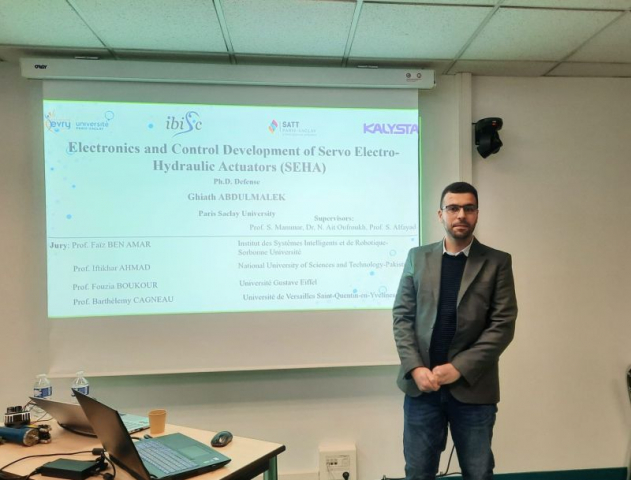Ghiath ABDULMALEK is defending his doctoral thesis on Monday, December 11, 2023, at 9:30 am on the Pelvoux site, room Ax101.
Title: Development of the electronics and control of servo-electrohydraulic actuators (SEHA)
Abstract
Humanoid robots represent a remarkable bridge between engineering, technology, and human aspirations. However, their development presents a series of significant challenges that go beyond mere technical obstacles. These challenges encompass fundamental aspects, such as power and energy requirements or sensing and perception capabilities. They also require complex control and decision-making algorithms. They involve the interdisciplinary field of human-robot interaction.
As such, actuation systems are essential components in the complex landscape of humanoid robots. Actuators are the heart of these machines, enabling them to perform precise, reliable and efficient movements. Moreover, they are responsible for reproducing the complexities and flexibility inherent in human musculature and joints. Tackling the actuator challenge is an essential step towards realizing advanced humanoid robots capable of engaging with the world naturally and effectively.
To meet these multiple objectives, we have proposed a revolutionary actuation technology known as the servo-electrohydraulic actuator (SEHA) (WO2020173933A1). SEHA introduces a paradigm shift in actuation systems thanks to very specific advantages. It autonomously generates hydraulic energy at each joint, thus optimizing energy utilization. In addition, SEHA incorporates a servo-force compensation function, enhancing the safety of human interaction.
Implementing SEHA requires a constellation of key components, including the EtherCAT layer for seamless communication, precise instrumentation and measurement for real-time feedback, firmware, and embedded software to ensure efficiency and responsiveness. SEHA design also requires comprehensive system analysis to optimize performance.
The path to realizing the potential of SEHA and related innovations led to the creation of the startup KALYSTA, supported by funding from SATT-Paris Saclay. In a modular approach to its products, soon to be offered for sale, KALYSTA has introduced a suite of by-products, including the Mini Groupe Hydraulique (MGH) for efficient hydraulic power generation, the Vérin Servo Instrumenté (SIC) for control loop testing, and the Kit de Développement, an integrated solution for actuator technology experimentation.
This thesis explores the electronic part of actuators, addressing the complex facets of their development, from fundamental challenges to state-of-the-art actuation technologies. Through SEHA’s objective and KALYSTA’s efforts, it seeks to usher in a new era of actuation technologies, creating more efficient and safer robotic systems for various applications.
The thesis comprises an introduction and seven main chapters, each contributing to the overall understanding of humanoid robots and actuation technology. Chapter 2 reviews the current state of knowledge in the field. Chapter 3 looks at a biomedical study of human muscle in relation to mechatronic actuation. Chapters 4 to 7 form the core of the contributions to developing the SEHA system: a review of its operating principles, simulation, control, electronics, and a new dynamic driver. Chapter 7 is devoted to the presentation of experimental results. The final chapter examines the achievements and outlines future directions and research.
Composition of the thesis jury
| Jury member | Title | Institution | Function in jury |
|---|---|---|---|
| Iftikhar AHMAD | Professor | National University of Sciences and Technology-Pakistan | Rapporteur |
| Naïma AITOUFROUKH-MAMMAR | Assistance professor | Université Paris-Saclay, Univ. Évry | Co-encadrante |
| Samer ALFAYAD | Full professor | Université Paris-Saclay, Univ. Évry | Co-encadrant |
| Faïz BEN AMAR | Full professor | Université Pierre et Marie Curie | Rapporteur |
| Fouzia BOUKOUR | Research director | Université Gustave Eiffel | Examinatrice |
| Barthélemy CAGNEAU | Assistant professor | Université de Versailles Saint-Quentin-en-Yvelines | Examinateur |
| Saïd MAMMAR | Full professor | Université Paris-Saclay, Univ. Évry | Directeur de thèse |
- Date: Monday 11/12/2023, 9:30 am
- Location: Pelvoux site, room Ax101
- Doctoral student: Ghiath ABDULMALEK (University of Evry, University of Paris Saclay, IBISC SIAM and IRA2 teams)
- Thesis supervisor: Saïd MAMMAR (Full professor, Univ. Évry, IBISC SIAM team)
- Thesis co-supervisors: Samer ALFAYAD (Full professor Univ. Évry, IBISC IRA2 team), Naïma AITOUFROUKH-MAMMAR (Assistant professor Univ. Évry, IBISC SIAM team)
- See the SATT Paris-Saclay SEHA 2019-2021 maturation project
- The thesis document is on HAL





